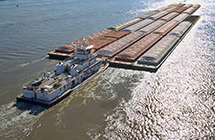 |
 |
|
| eNews • February 2018 | ||
| Promoting a Cost-Effective, Reliable and Competitive Transportation System |
||
 STC Releases "Top 10 Most Wanted List" of Infrastructure Priorities
STC Releases "Top 10 Most Wanted List" of Infrastructure Priorities
As the nation increasingly examines and explores the need to enhance our multi-modal transportation system, many suggestions from policymakers and constituents have been long on ambition but short on specifics. Moreover, there is a concern within agriculture that the transportation interests of urban areas could exclude the interests of rural areas.
In an effort to ensure the transportation needs of the U.S. soybean industry are understood and considered in the midst of this national debate, the Soy Transportation Coalition (STC) released its "Top 10 Most Wanted List" of infrastructure priorities.
"Farmers should realize that if we are unwilling to promote the transportation solutions that would benefit our industry, we should not expect others to do so," says Gerry Hayden, a soybean farmer from Calhoun, Kentucky and chairman of the Soy Transportation Coalition. "During this pivotal time in which the White House and Congress are developing a strategy for improving our multi-modal transportation system, it is critical the farmer perspective has a seat at the table."
Given how soybeans and many agricultural products have arguably the most diverse and elongated supply chain of any industry, the list highlights opportunities to enhance rural roads and bridges, highways and interstates, freight rail service, the inland waterway system, and ports. The STC board of directors also decided to simply list the top ten priorities, rather than ranking them against each other.
Top 10 Most Wanted List
"In developing the list, the Soy Transportation Coalition board of directors did not want to simply promote those infrastructure projects with the largest price tag," says Hayden. "Some of the items on the list certainly do involve more federal investment, which we believe is appropriate. However, we also believe many of our transportation challenges can be addressed by implementing smarter regulations and by practicing better stewardship of taxpayer dollars."
"When it comes to transportation, I would rather the federal government be predictably good than sporadically great," explains Mike Steenhoek, executive director of the Soy Transportation Coalition. "In order for the soybean industry to remain profitable, we must be responsive and nimble in an increasingly dynamic global marketplace. We therefore need the federal government to help provide and maintain our multi-modal transportation network in a condition that inspires confidence and future investment. One of the best ways of accomplishing this is for federal government to promote greater predictability and reliability in how our transportation assets are maintained and how funding is provided. This is currently not occurring. We are hopeful that by calling greater attention to a number of the specific transportation needs of the soybean industry and much of U.S. agriculture the federal government will become more of a facilitator of our global competitiveness and less of an obstacle to it."
Source: Soy Transportation Coalition
Soy Transportation Coalition |
|
